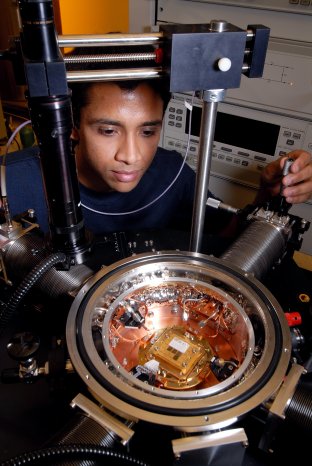By comparison, 500 GHz is more than 250 times faster than today's cell phones, which typically operate at approximately 2 GHz. Computer simulations suggest that the silicon-germanium (SiGe) technology used in the chip could ultimately support even higher (near-TeraHertz – 1,000 GHz) operational frequencies even at room temperature.
The experiments, conducted jointly by IBM and Georgia Tech researchers, are part of a project to explore the ultimate speed limits of silicon-germanium (SiGe) devices, which operate faster at very cold temperatures. The chips used in the research are from a prototype fourth-generation SiGe technology fabricated by IBM on a 200-millimeter wafer. At room temperature, they operated at approximately 350 GHz.
“For the first time, Georgia Tech and IBM have demonstrated that speeds of half a trillion cycles per second can be achieved in a commercial silicon-based technology, using large wafers and silicon-compatible low-cost manufacturing techniques,” said John D. Cressler, Byers Professor in Georgia Tech’s School of Electrical and Computer Engineering, and a researcher in the Georgia Electronic Design Center (GEDC) at Georgia Tech. “This work redefines the upper bounds of what is possible using silicon-germanium nanotechnology techniques.”
"This groundbreaking collaborative research by Georgia Tech and IBM redefines the performance limits of Silicon-based semiconductors," said Bernie Meyerson, vice president and chief technologist, IBM Systems and Technology Group. "IBM is committed to working closely with our academic and industry partners to deliver the insight and innovation that will enable a new generation of high-performance, energy efficient microprocessors."
SiGe is a process technology in which the electrical properties of silicon, the material underlying virtually all modern microchips, is augmented with germanium to make chips operate more efficiently. SiGe boosts performance and reduces power consumption in chips that go into cellular phones and other advanced communication devices. IBM first announced its SiGe technology in 1989, and later introduced SiGe into the industry's first standard, high-volume SiGe chips in October 1998. Since that time, it has shipped hundreds of millions of SiGe chips.
Ultra-high-frequency silicon-germanium circuits have potential applications in commercial communications systems, defense electronics, space exploration, and remote sensing. Achieving such extreme speeds in silicon-based technology – which can be manufactured using conventional low-cost techniques – could provide a pathway to high-volume applications. Until now, only integrated circuits fabricated from more costly “III-V” compound semiconductor materials have achieved such extreme levels of transistor performance.
Better understanding the physics of silicon-germanium devices – and ultimately the circuits that can be built from them – will provide important clues to improvements needed in the future.
“We observe effects in these devices at cryogenic temperatures which potentially make them faster than simple theory would suggest, and may allow us to ultimately make the devices even faster,” Cressler explained. “Understanding the basic physics of these advanced transistors arms us with knowledge that could make the next generation of silicon-based integrated circuits even better.”
Silicon-germanium technology has been of great interest to the electronics industry because it allows substantial transistor performance improvements to be achieved while using fabrication techniques compatible with standard high-volume silicon-based manufacturing processes. By introducing germanium into silicon wafers at the atomic scale, engineers can boost dramatically performance while retaining the many advantages of silicon.
In addition to Cressler, the research team included Georgia Tech Ph.D. students Ramkumar Krithivasan and Yuan Lu; Jae-Sun Rieh of Korea University in Seoul, South Korea (formerly with IBM); and Marwan Khater, David Ahlgren and Greg Freeman of IBM Microelectronics in East Fishkill, N.Y. The accomplishment will be reported in the July issue of the journal IEEE Electron Device Letters. The research has been supported by IBM, NASA, and the GEDC at Georgia Tech.
